- 1School of Engineering, Guangzhou College of Technology and Business, Foshan, China
- 2Rice Research Institute, Guangdong Academy of Agricultural Sciences, Guangzhou, China
Introduction: Over the past three decades, Guangdong Province has released numerous rice varieties, but comprehensive analyses of their yield and quality characteristics remain limited.
Methods: This study systematically evaluated a total of 982 rice varieties released in Guangdong Province from 1990 to 2020, focusing on grain yield, yield components, and quality parameters.
Results and discussion: The results revealed that the number of inbred rice varieties was significantly lower than that of hybrid rice varieties, while the number of high-quality late rice varieties was greater than that of high-quality early rice varieties. Temporal analysis showed significant increases in the release of inbred rice, hybrid rice, and high-quality hybrid late rice varieties. Hybrid rice demonstrated superior grain yield (6.98 t hm−2) compared to inbred rice (6.50 t hm−2), which was primarily attributable to enhanced spikelet per panicle and grain weight. Both inbred and hybrid rice exhibited significant yield improvements over time, driven by increases in spikelet per panicle, filled grain percentage, or grain weight. Notably, the panicle number of both inbred and hybrid rice displayed a significant declining trend. Quality analysis indicated that inbred rice surpassed hybrid rice in head rice rate and chalkiness, while late rice outperformed early rice in these parameters. Early rice exhibited higher gel consistency but lower amylose content compared to late rice. However, both inbred and hybrid rice showed declining trends in head rice rate, chalkiness, and amylose content over the study period. In the future, rice breeding strategies in Guangdong should focus on improving spikelet per panicle and grain weight in inbred rice, and enhancing panicle number in both inbred and hybrid rice varieties to achieve further yield improvement. Furthermore, the development of new varieties should prioritize higher head rice rate, particularly for early rice. These findings provide crucial insights into the evolving patterns of grain yield and quality in Guangdong Province, offering valuable guidance for future breeding strategies and cultivation practices.
1 Introduction
Rice (Oryza sativa L.), a cornerstone of China’s agricultural production, is one of the most vital food crops in the country. Guangdong Province, a key economic, demographic, and agricultural hub, has historically been a major rice-producing region, with rice serving as its staple crop. The evolution of rice breeding in Guangdong can be traced back to the early 20th century, progressing through distinct phases such as dwarf breeding, hybrid rice breeding, super rice breeding, high-quality breeding, and molecular genetic breeding (Liu et al., 2010; Zhou et al., 2022). Over the past three decades, the province has witnessed a substantial rise in the number of newly bred and released rice varieties, driving multiple generational shifts in rice traits (Liu et al., 2010; Wang, 2024).
However, rice production in Guangdong Province has encountered a bottleneck in terms of cultivation area, total yield, and yield per unit area. In the early 1990s, the rice cultivation area exceeded 3.1 million hectares, yielding 16.8 million tons (Guangdong Rural Statistical Yearbook Editorial Board, 1991–2021). In recent years, the cultivation area has stabilized at approximately 1.8 million hectares, with yields maintaining around 11.0 million tons (Guangdong Rural Statistical Yearbook Editorial Board, 1991–2021). Additionally, the rice yield per unit area in Guangdong has exhibited significant fluctuations, peaking at 6.30 t hm−2 in 2000 before gradually declining and stabilizing at approximately 6.00 t hm−2, which is notably lower than the national average of 7.19 t hm−2 (Guangdong Rural Statistical Yearbook Editorial Board, 1991–2021). These trends are closely linked to the characteristics of the varieties released and promoted during these periods. Moreover, global climate change, population growth, shrinking arable land, and environmental constraints pose unprecedented challenges to rice production in the region.
With the advancement of socio-economic development and the improvement of living standards, the demand for high-quality rice has significantly increased, making quality a pivotal criterion in rice variety selection and breeding. Guangdong Province, located in the south of subtropical China, benefits from abundant temperature, light, and water resources, positioning it as a leader in the breeding of high-quality rice varieties. Over the years, Guangdong has been at the forefront of high-quality indica rice breeding, releasing numerous superior varieties and establishing itself as a major production base for high-quality indica rice, with Simiao rice gaining particular recognition.
Recent studies have explored the impact of rice breeding processes on grain yield and rice quality improvements in China, summarizing trends in yield and quality for indica and japonica rice, as well as for early, mid-season, and late rice across different regions (Wang et al., 2017; Fei et al., 2020; Zhou et al., 2022; Zou et al., 2024). However, most of these studies have focused on specific time periods or localized areas, leaving a gap in the systematic analysis of the effects of varietal evolution in Guangdong Province on rice yield and quality. Therefore, there is an urgent need to elucidate these changes through long-term data analysis to better understand the temporal changes in rice breeding in this region.
This study focuses on data from rice varieties released in Guangdong from 1990 to 2020, analyzing key agronomic traits such as grain yield and rice quality, and their evolutionary trends. The objectives of this research are threefold: (1) to assess the contribution of varietal improvement to grain yield and quality, (2) to identify bottlenecks in trait advancement, and (3) to propose breeding strategies aligned with sustainable production goals. By addressing these objectives, the study aims to provide critical insights for optimizing rice breeding in Guangdong and other similar subtropical regions, addressing the dual imperatives of productivity and quality in the context of a changing climate.
2 Materials and methods
In this study, the grain yield, growth period, yield components, and quality data of a total of 982 rice varieties released in Guangdong Province from 1990 to 2020 were obtained from the Big Data Platform of the China Seed Industry (http://202.127.42.232/SDSite/Home/Index). Varieties were categorized into four major types based on season and genotype: inbred early rice (IER), inbred late rice (ILR), hybrid early rice (HER), and hybrid late rice (HLR). The grain yield data represent the average yield of the regional trials over two years. Additionally, rice varieties that meet the standards of “Cooking Rice Variety Quality” (NY/T 593-2013, 2013) or “High Quality Long-Grain Paddy in Guangdong” (DB44/ 181-2004, 2004) and achieve third-grade quality or above are classified as high-quality rice varieties, and are divided into four categories: high-quality inbred early rice (HQIER), high-quality inbred late rice (HQILR), high-quality hybrid early rice (HQHER), and high-quality hybrid late rice (HQHLR). Statistical analysis was conducted using Microsoft Excel 2021 and SPSS 20 software.
3 Results
3.1 The number of released rice varieties
From 1990 to 2020, a total of 149 IER, 174 ILR, 319 HER, and 340 HLR varieties were released in Guangdong Province (Figure 1A). Among these, 60 HQIER (40.3%), 147 HQILR (84.5%), 45 HQHER (14.1%), and 219 HQHLR (64.4%) were identified as high-quality varieties (Figures 1B, C). The number of IER, ILR, HER, and HLR showed a significant increasing trend, with HER and HLR exhibiting a higher rate of increase than IER and ILR (Figures 2A–D). Differently, the number of HQIER, HQILR, and HQHER did not show a significant trend (Figures 2E–G), while HQHLR demonstrated a significant increase (Figure 2H).
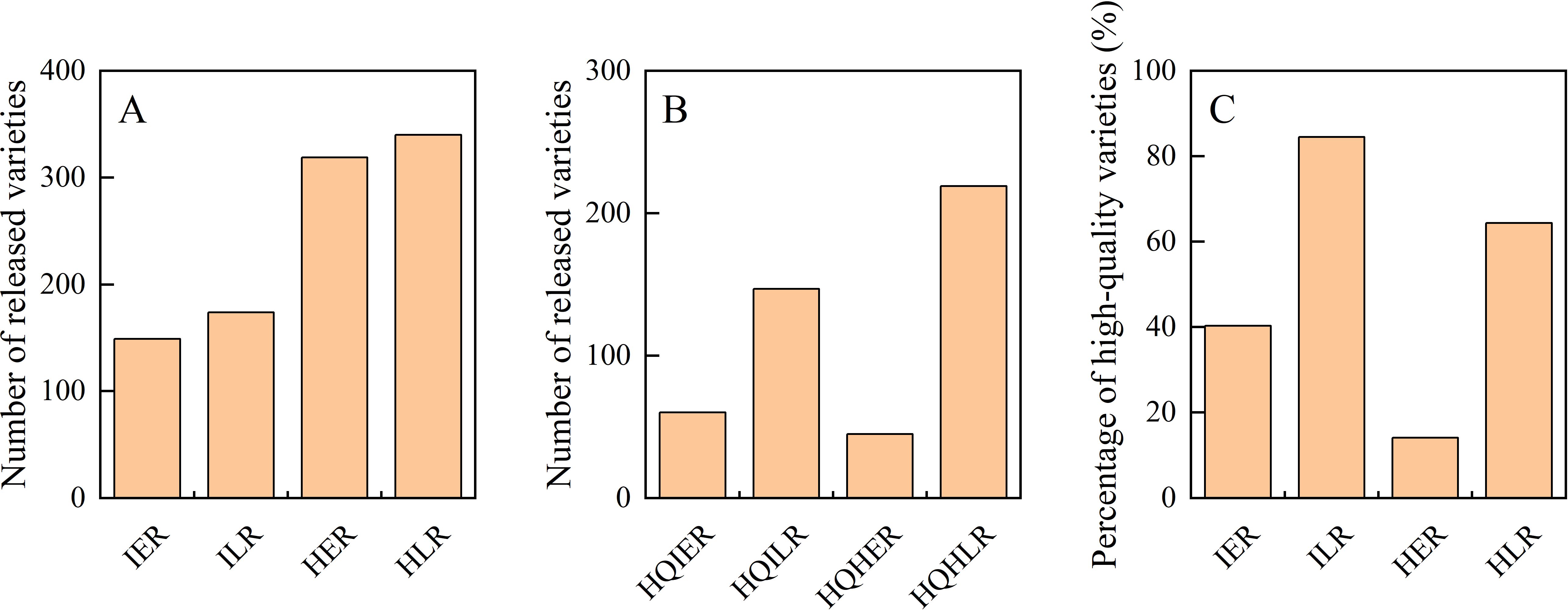
Figure 1. The number of rice varieties released in Guangdong Province from 1990 to 2020. IER, inbred early rice; ILR, inbred late rice; HER, hybrid early rice; HLR, hybrid late rice; HQIER, high-quality inbred early rice; HQILR, high-quality inbred late rice; HQHER, high-quality hybrid early rice; HQHLR, high-quality hybrid late rice.
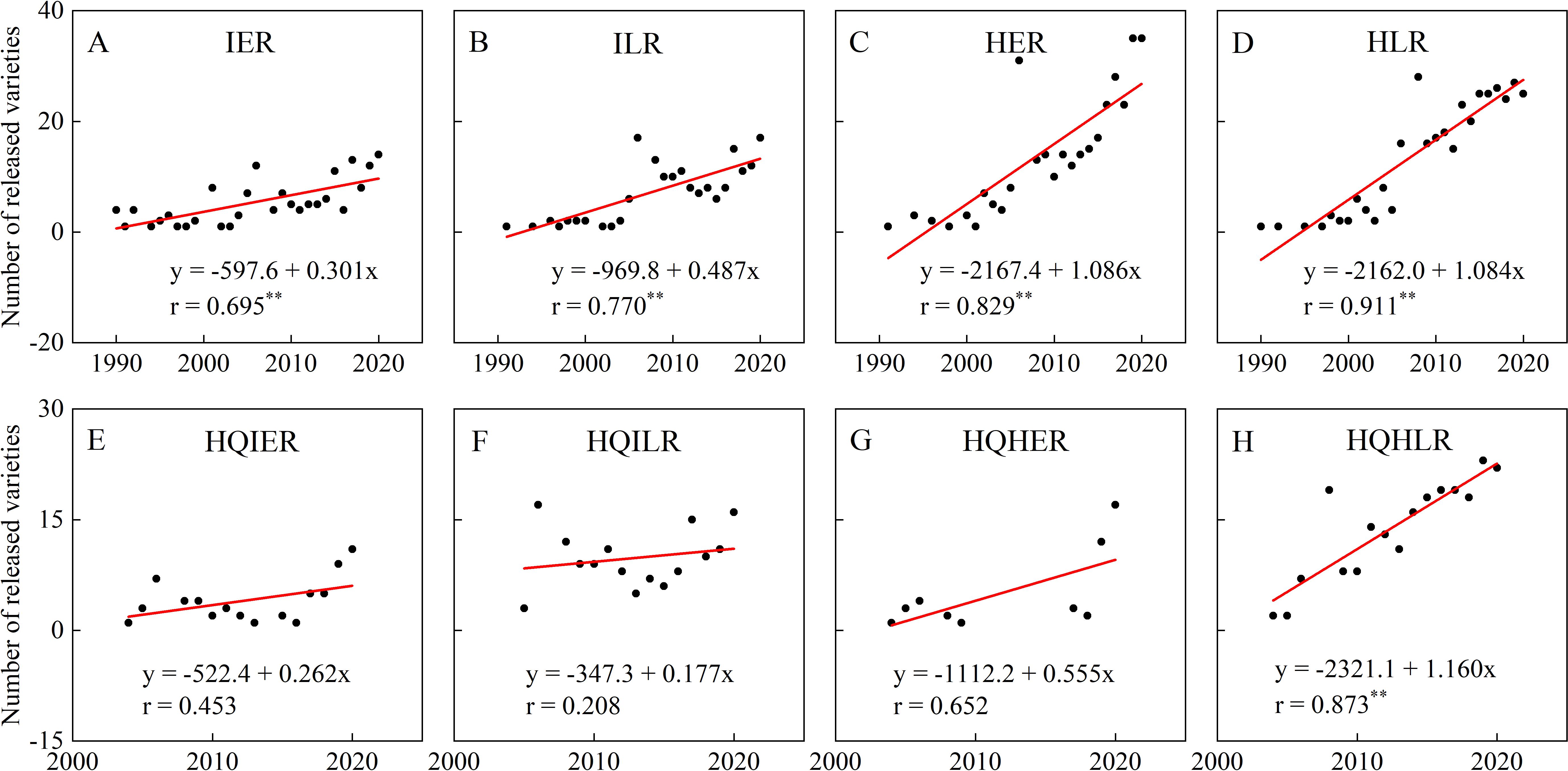
Figure 2. Trends in rice varieties released in Guangdong Province from 1990 to 2020. IER, inbred early rice; ILR, inbred late rice; HER, hybrid early rice; HLR, hybrid late rice; HQIER, high-quality inbred early rice; HQILR, high-quality inbred late rice; HQHER, high-quality hybrid early rice; HQHLR, high-quality hybrid late rice. ** indicates significance at P < 0.01.
3.2 Grain yield, growth period, and yield components of released rice varieties
The average grain yields of IER, ILR, HER, and HLR in Guangdong Province were 6.54 t hm−2, 6.46 t hm−2, 7.02 t hm−2, and 6.94 t hm−², respectively (Figure 3A). HER and HLR exhibited significantly higher yields than IER and ILR, with increases of 0.48 t hm−2 each. The growth period varied significantly between seasons, with IER and HER showing 15.3 and 11.5 days longer durations than ILR and HLR, respectively (Figure 3B). Yield components, including panicle number, spikelet per panicle, filled grain percentage, and grain weight, differed significantly between inbred and hybrid rice (Figures 3C–F). Compared to IER and ILR, HER and HLR demonstrated a 10.0% and 8.1% reduction in panicle number, a 6.9% and 4.8% increase in spikelet per panicle, a 1.6% and 1.5% decrease in filled grain percentage, and a 12.7% and 13.8% increase in grain weight, respectively. Additionally, ILR showed a 2.5% reduction in panicle number and a 2.7% increase in spikelet per panicle compared to IER (Figures 3C, D).
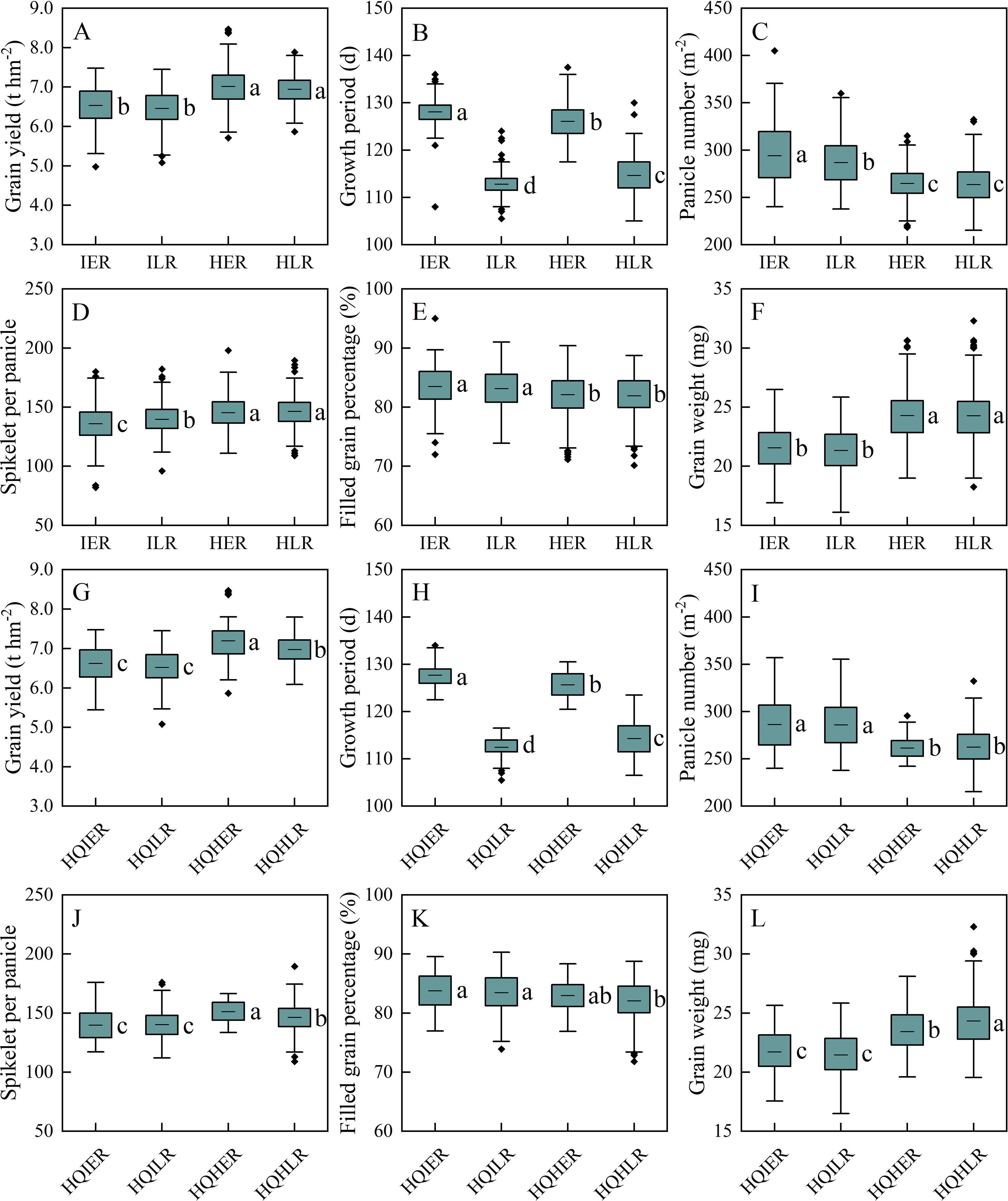
Figure 3. Average grain yield, growth period, and yield components of rice varieties released in Guangdong Province from 1990 to 2020. IER, inbred early rice; ILR, inbred late rice; HER, hybrid early rice; HLR, hybrid late rice; HQIER, high-quality inbred early rice; HQILR, high-quality inbred late rice; HQHER, high-quality hybrid early rice; HQHLR, high-quality hybrid late rice. Different lowercase letters indicate significant differences (LSD test, P < 0.05). The horizontal line within each box is the mean value, the upper and lower limits of the box represent the upper and lower quartiles.
For high-quality rice, HQIER, HQILR, HQHER, and HQHLR achieved average grain yields of 6.63 t hm−2, 6.52 t hm−2, 7.20 t hm−2, and 6.97 t hm−2, respectively (Figure 3G). HQHER and HQHLR yielded significantly higher than HQIER and HQILR, with increases of 0.57 t hm−2 and 0.45 t hm−2, respectively, while HQHLR yielded 0.23 t hm−2 less than HQHER. The growth period of high-quality rice also varied significantly between seasons, with HQIER and HQHER being 15.3 and 11.3 days longer than HQILR and HQHLR, respectively (Figure 3H). Yield components of high-quality rice also exhibited significant differences between inbred and hybrid rice. Panicle number decreased by 8.7% and 8.2% for HQHER and HQHLR compared to HQIER and HQILR, while spikelet per panicle increased by 8.1% and 4.4%, and grain weight rose by 7.9% and 13.4%, respectively (Figures 3I, J, L). The filled grain percentage of HQILR was significantly higher than that of HQHLR (Figure 3K). Additionally, HQHER had significantly more spikelet per panicle but lower grain weight than HQHLR (Figures 3J, L).
The grain yields of IER, ILR, HER, and HLR demonstrated significant increasing trends (Figures 4A–D). In contrast, the growth periods of IER, HER, and HLR showed significant declines (Figures 4E, G, H), while ILR exhibited no significant change (Figure 4F). Yield components analysis revealed a significant reduction in panicle number for all rice types (Figures 4I–L), while spikelet per panicle increased significantly (Figures 4M–P). The filled grain percentage of IER, ILR, and HER rose significantly (Figures 4Q–S), whereas no significant change was observed in HLR (Figure 4T). Additionally, grain weight of IER and ILR showed significant grains (Figures 4U, V), but remained unchanged in HER and HLR (Figures 4W, X).
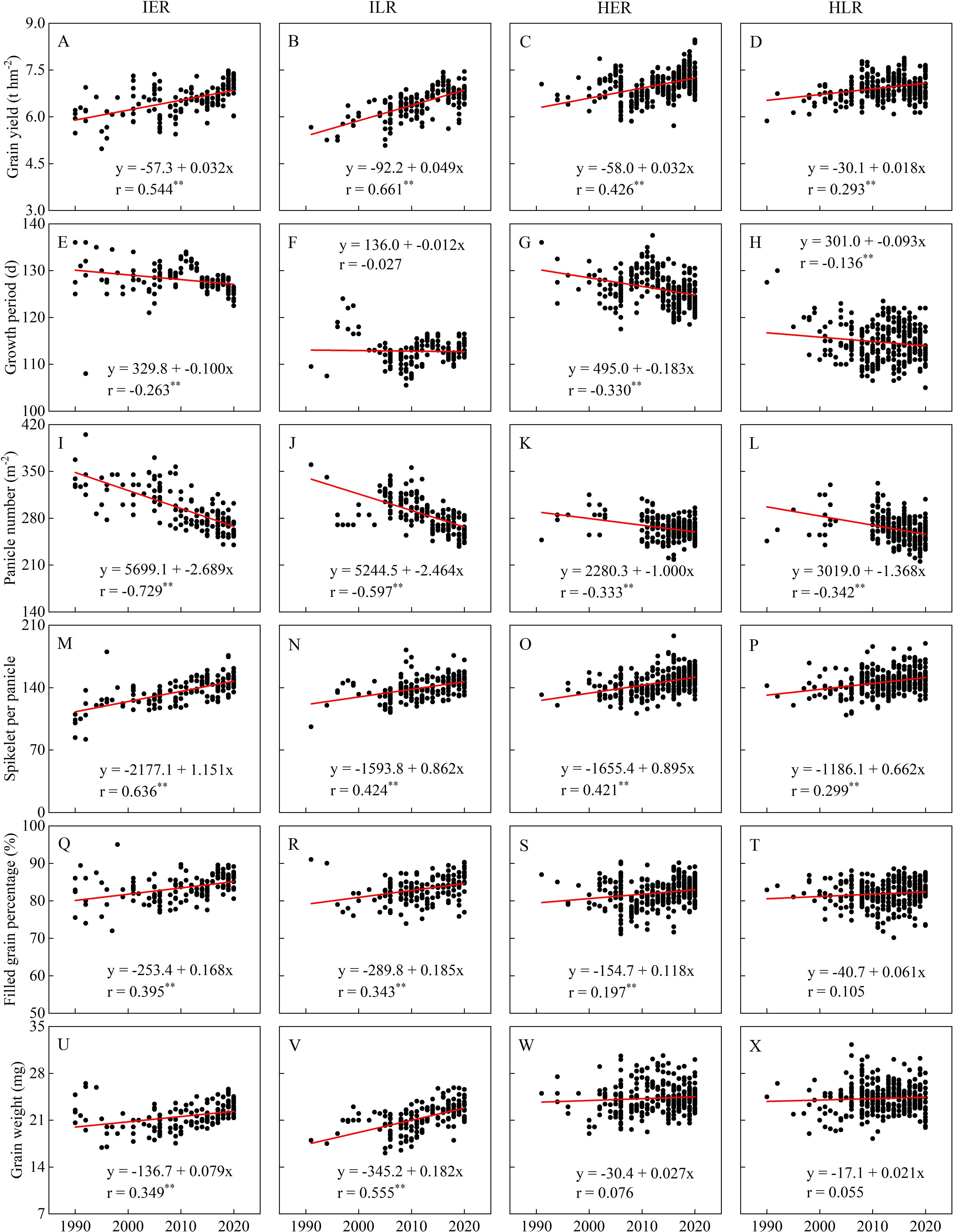
Figure 4. Trends in grain yield, growth period, and yield components of rice varieties released in Guangdong Province from 1990 to 2020. IER (A, E, I, M, Q, U), inbred early rice; ILR (B, F, J, N, R, V), inbred late rice; HER (C, G, K, O, S, W), hybrid early rice; HLR (D, H, L, P, T, X), hybrid late rice. ** indicates significance at P < 0.01.
For high-quality rice, the grain yields of HQIER, HQILR, and HQHER increased significantly (Figures 5A–C), whereas HQHLR exhibited no significant trend (Figure 5D). The growth period of HQIER declined significantly, while HQILR showed a significant increase (Figures 5E, F). In contrast, HQHER and HQHLR exhibited no significant changes in growth period (Figures 5G, H). Yield components of high-quality inbred rice displayed notable changes: panicle number of HQIER and HQILR decreased significantly (Figures 5I, J), while spikelet per panicle, filled grain percentage, and grain weight increased significantly (Figures 5M, N, Q, R, U, V). For high-quality hybrid rice, HQHER exhibited a significant rise in spikelet per panicle and grain weight (Figures 5O, W), while there were no significant changes in panicle number and filled grain percentage (Figures 5K, S). HQHLR showed a significant reduction in panicle number (Figure 5L), along with increased spikelet per panicle and filled grain percentage (Figures 5P, T), but no change in grain weight (Figure 5X).
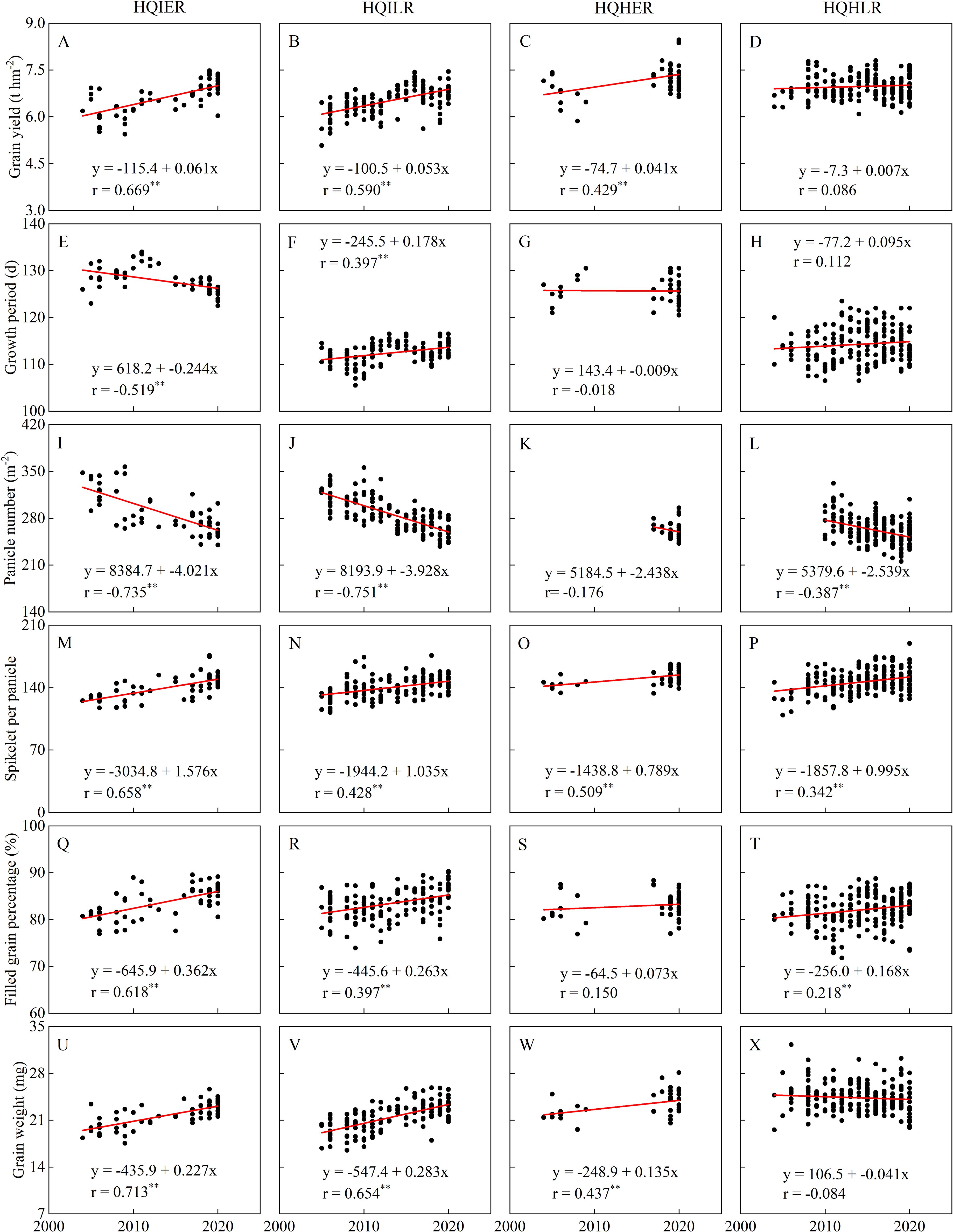
Figure 5. Trends in grain yield, growth period, and yield components of high-quality rice varieties released in Guangdong Province from 1990 to 2020. HQIER (A, E, I, M, Q, U), high-quality inbred early rice; HQILR (B, F, J, N, R, V), high-quality inbred late rice; HQHER (C, G, K, O, S, W), high-quality hybrid early rice; HQHLR (D, H, L, P, T, X), high-quality hybrid late rice. ** indicates significance at P < 0.01.
3.3 Quality of released rice varieties
The head rice rates of IER, ILR, HER, and HLR were 53.5%, 66.2%, 46.6%, and 61.7%, respectively (Figure 6A), with corresponding chalkiness of 3.9%, 1.7%, 9.0%, and 5.1% (Figure 6B). IER and HER exhibited significantly lower head rice rates and higher chalkiness compared to ILR and HLR, while IER and ILR showed higher head rice rates and lower chalkiness than HER and HLR. The gel consistency of IER, ILR, HER, and HLR were 73.7 mm, 67.2 mm, 69.6 mm, and 65.5 mm, respectively (Figure 6C), with amylose contents of 16.6%, 17.7%, 18.2%, and 18.9% (Figure 6D). IER and HER had significantly higher gel consistency and lower amylose content than ILR and HLR, while IER and ILR displayed higher gel consistency and lower amylose content than HER and HLR.
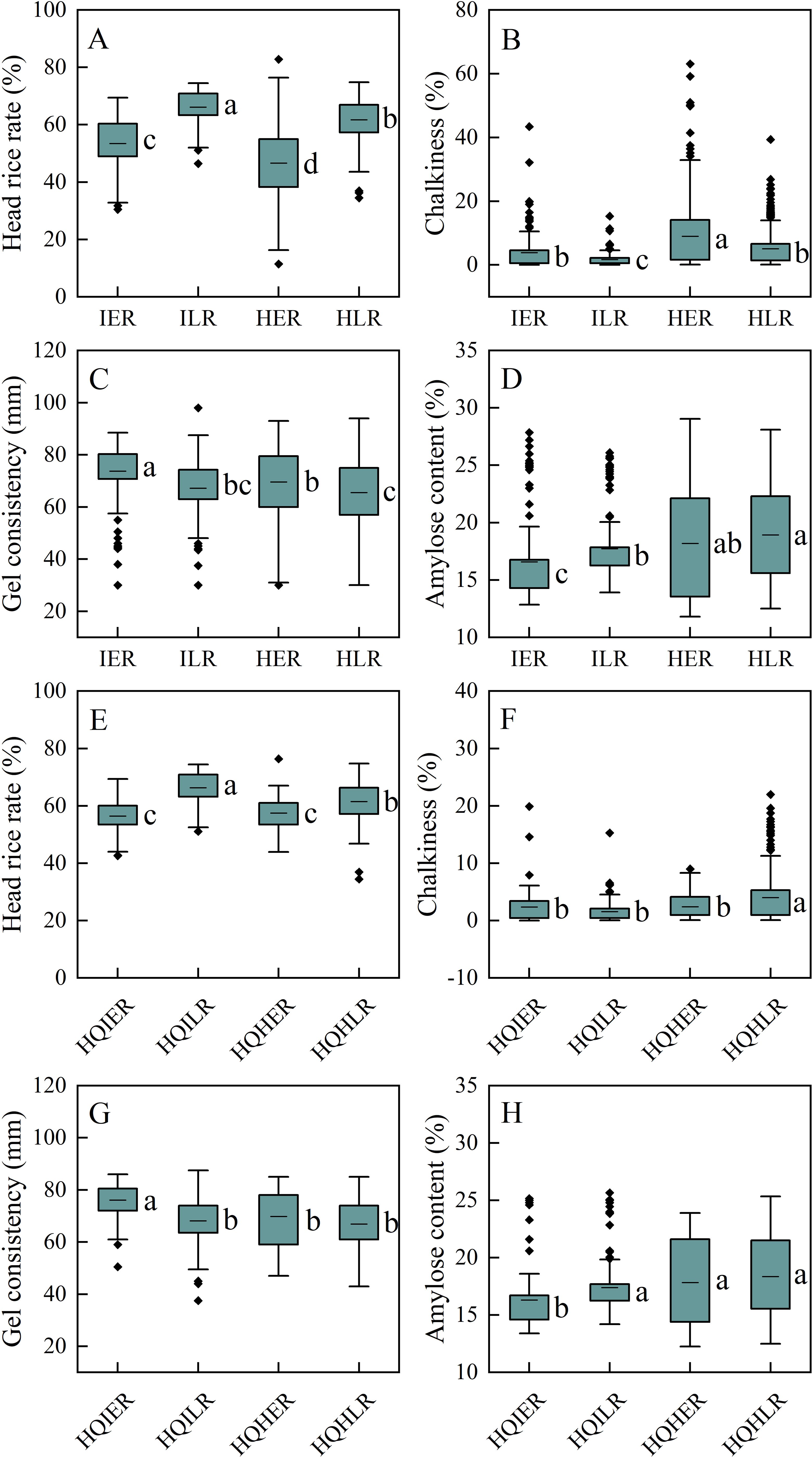
Figure 6. Average head rice rate, chalkiness, gel consistency, and amylose content of rice varieties released in Guangdong Province from 1990 to 2020. IER, inbred early rice; ILR, inbred late rice; HER, hybrid early rice; HLR, hybrid late rice; HQIER, high-quality inbred early rice; HQILR, high-quality inbred late rice; HQHER, high-quality hybrid early rice; HQHLR, high-quality hybrid late rice. Different lowercase letters indicate significant differences (LSD test, P < 0.05). The horizontal line within each box is the mean value, the upper and lower limits of the box represent the upper and lower quartiles.
For the high-quality rice (HQIER, HQILR, HQHER, HQHLR), head rice rates were 56.4%, 66.3%, 57.5%, and 61.5%, respectively (Figure 6E), with chalkiness of 2.4%, 1.6%, 2.4%, and 4.0% (Figure 6F). Gel consistency were 76.1 mm, 68.1 mm, 69.8 mm, and 66.9 mm (Figure 6G), while amylose contents were 16.3%, 17.4%, 17.8%, and 18.3% (Figure 6H). HQIER and HQHER showed significantly lower head rice rates than HQILR and HQHLR, with HQILR exceeding HQHLR. Chalkiness was significantly lower in HQIER, HQILR, and HQHER compared to HQHLR. HQIER exhibited significantly higher gel consistency than HQILR, HQHER, and HQHLR but lower amylose content.
Trend analysis revealed significant decreases in head rice rate, chalkiness, and amylose content for IER, ILR, HER, and HLR (Figures 7A–H, M–P). Gel consistency increased significantly for IER, HER, and HLR (Figures 7I, K, L), while ILR showed a significant decrease (Figure 7J). In high-quality rice, HQIER exhibited significant reductions in head rice rate and chalkiness, with no clear trends in gel consistency or amylose content (Figures 8A, E, I, M). HQILR displayed significant declines in all parameters: head rice rate, chalkiness, gel consistency, and amylose content (Figures 8B, F, J, N). HQHER showed significant reductions in chalkiness and amylose content, with no definitive trends in head rice rate or gel consistency (Figures 8C, G, K, O). HQHLR demonstrated significant decreases in head rice rate, chalkiness, and amylose content, while gel consistency increased (Figures 8D, H, L, P).
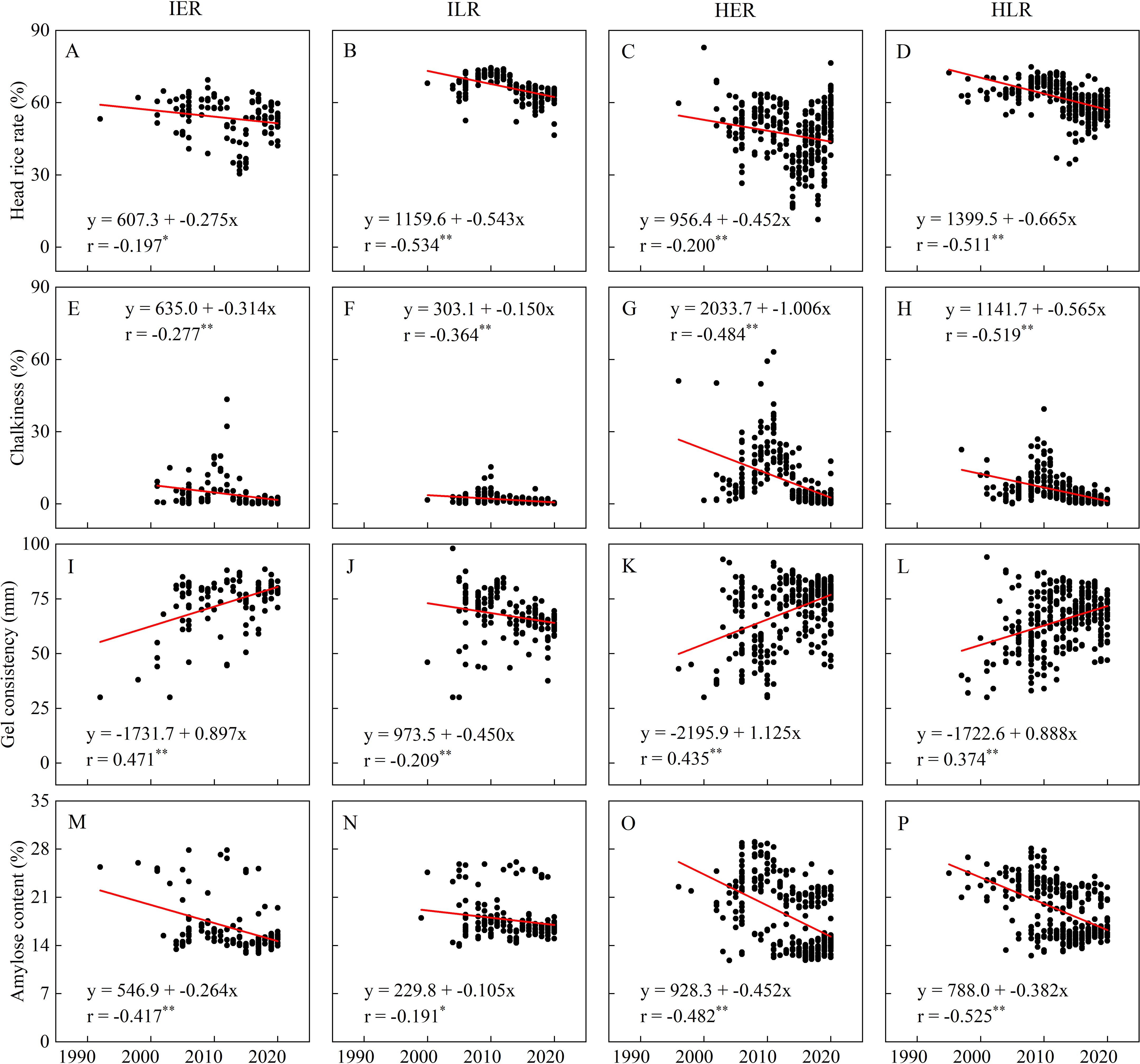
Figure 7. Trends in head rice rate, chalkiness, gel consistency, and amylose content of rice varieties released in Guangdong Province from 1990 to 2020. IER (A, E, I, M), inbred early rice; ILR (B, F, J, N), inbred late rice; HER (C, G, K, O), hybrid early rice; HLR (D, H, L, P), hybrid late rice. * indicates significance at P < 0.05; ** indicates significance at P < 0.01.
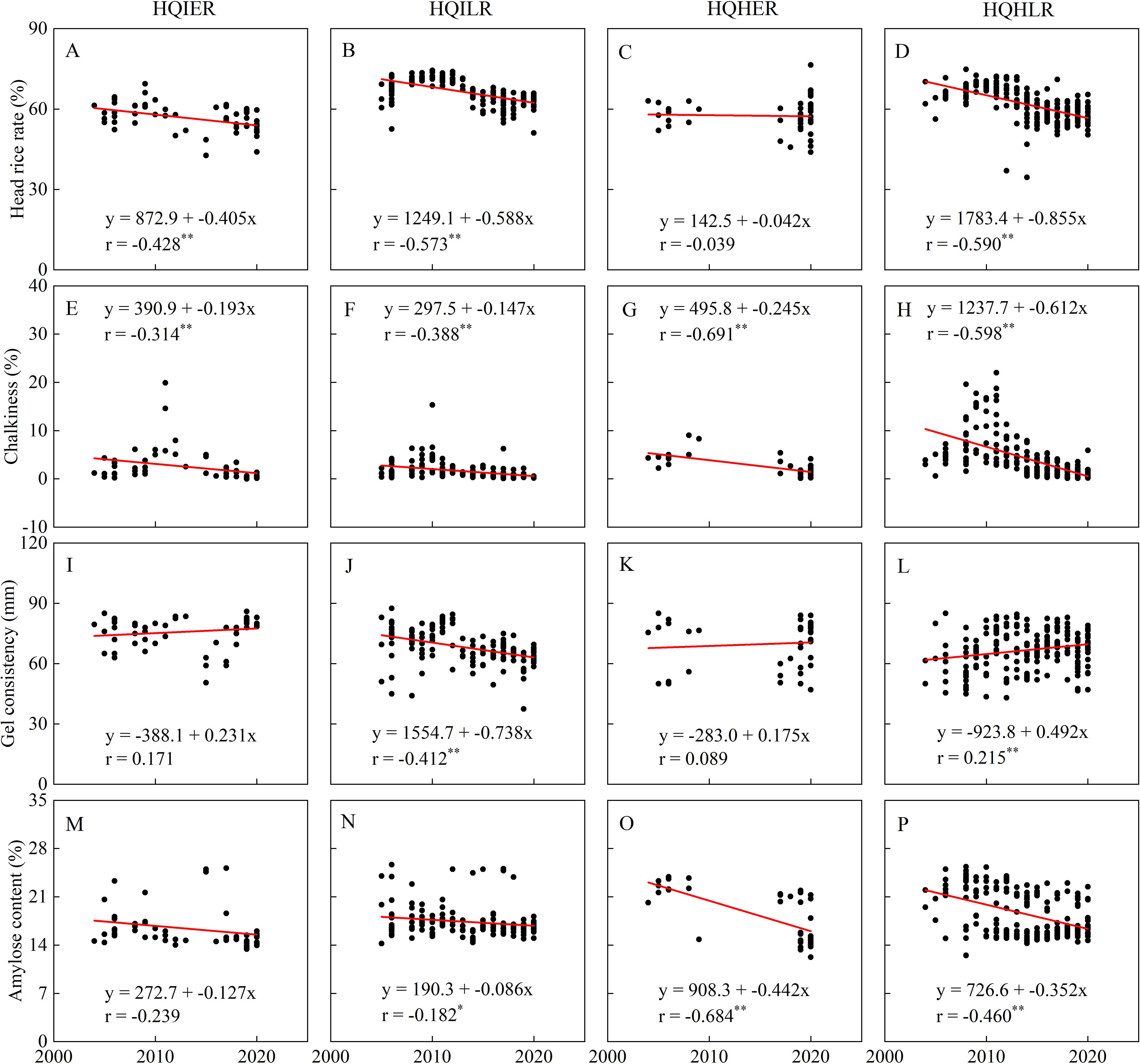
Figure 8. Trends in head rice rate, chalkiness, gel consistency, and amylose content of high-quality rice varieties released in Guangdong Province from 1990 to 2020. HQIER (A, E, I, M), high-quality inbred early rice; HQILR (B, F, J, N), high-quality inbred late rice; HQHER (C, G, K, O), high-quality hybrid early rice; HQHLR (D, H, L, P), high-quality hybrid late rice. * indicates significance at P < 0.05; ** indicates significance at P < 0.01.
4 Discussion
4.1 The number of rice varieties released in Guangdong Province from 1990 to 2020
From 1990 to 2020, hybrid rice varieties, including HER and HLR, significantly outnumbered inbred rice varieties (IER and ILR) in Guangdong Province (Figure 1A). This dominance reflects the well-established advantages of hybrid rice in terms of grain yield, stress resistance, and grower preference (Goff, 2011; Villa et al., 2012; Fei et al., 2020). The observed disparity can be partially attributed to the shorter breeding cycle of hybrid rice compared to inbred rice. Specifically, hybrid rice breeding systems (e.g., three-line or two-line methods) typically require 3 to 5 years to develop new cultivars, whereas inbred rice necessitates 6 to 8 years of successive pedigree selection to achieve genetic stability. Furthermore, the number of HQILR and HQHLR varieties significantly exceeded those of HQIER and HQHER (Figure 1B). The higher percentage of high-quality late rice (Figure 1C) is likely attributed to favorable environmental conditions during its growth period, characterized by optimal light, temperature, and water resources, which promote stable yields, superior grain quality, and greater market acceptance.
The number of released inbred and hybrid rice varieties exhibited a significant upward trend, with hybrid rice expanding at a faster rate, particularly after the implementation of China’s Seed Law in 2000 (Figures 2A–D). Among high-quality rice varieties, only HQHLR demonstrated a significant increase (Figure 2H), highlighting its growing recognition and promotion due to its high yield and superior quality. This trend is expected to drive continued investment and innovation in HQHLR breeding. In contrast, the slow growth rates of HQIER, HQILR, and HQHER indicate persistent challenges in their breeding and promotion. However, these varieties remain essential as genetic resources for maintaining biodiversity and addressing future climate change challenges.
4.2 Grain yield of rice varieties released in Guangdong Province from 1990 to 2020
From 1990 to 2020, the grain yield of IER and ILR released in Guangdong Province was significantly lower than that of HER and HLR (Figure 3A). A similar trend was observed among high-quality rice varieties, with hybrid rice outperforming inbred rice (Figure 3G). These findings underscore the superior yield improvement achieved through hybrid rice breeding compared to inbred rice, primarily due to heterosis. Heterosis in hybrid rice is well-documented and is attributed to enhanced root systems, higher photosynthetic efficiency, and improved nutrient utilization (Bueno and Lafarge, 2009; Zhang et al., 2009; Yuan et al., 2017).
Yield components such as panicle number, spikelet per panicle, filled grain percentage, and grain weight are critical determinants of rice yield and are key targets for breeding improvement. Hybrid rice’s high yield potential is largely driven by greater spikelet per panicle and grain weight (Villa et al., 2012; Jiang et al., 2016; Takahashi et al., 2023). In this study, grain yield across all rice varieties showed a significant positive correlation with spikelet per panicle and grain weight (Supplementary Figures S1E, I). Consequently, the high grain yield of HER and HLR can be attributed to their superior performance in these traits (Figures 3D, F). While inbred rice exhibited advantages in panicle number and filled grain percentage (Figures 3C, E), its lower spikelet per panicle and grain weight limited further yield gains (Figures 3D, F). Similarly, high-quality rice varieties demonstrated a significant positive correlation between grain yield and spikelet per panicle and grain weight (Supplementary Figures S1F, J), with high-quality hybrid rice excelling in these traits (Figures 3J, L). The genetic mechanisms underlying heterosis have been extensively studied, with dominance effects and overdominance/pseudo-overdominance identified as key contributors to yield, spikelet per panicle, and grain weight heterosis (Zhou et al., 2012; Huang et al., 2016). However, hybrid rice tends to exhibit lower panicle number and filled grain percentage compared to inbred rice, potentially influenced by rice population structure (Gong et al., 2012; Xu et al., 2020).
These findings suggest that future rice breeding strategies in Guangdong should focus on two primary approaches: (1) increasing spikelet per panicle and grain weight in inbred rice, or (2) enhancing panicle number and filled grain percentage in hybrid rice. In addition, balancing these yield components while emphasizing specific traits will be essential for achieving higher yield levels. Notably, the grain yield of high-quality rice was comparable to that of total rice within the same types and seasons (Figures 3A, G), indicating that high yield and high quality are not mutually exclusive objectives (Wang et al., 2021; Yu et al., 2022; Chen et al., 2024).
From 1990 to 2020, the grain yields of both inbred and hybrid rice in Guangdong Province exhibited an upward trajectory (Figures 4A–D), consistent with the findings of Fei et al. (2020), who reported an annual increase of 0.95% in China’s rice yield from 2004 to 2018. This trend underscores the continuous and effective exploitation of yield potential through long-term breeding improvements and optimized cultivation practices. The increase in national rice yield has been primarily driven by improvements in spikelet per panicle and filled grain percentage (Fei et al., 2020). In this study, the grain yield of IER and ILR showed significant positive correlations with spikelet per panicle (Supplementary Figures S2I, J), filled grain percentage (Supplementary Figures S2M, N), and grain weight (Supplementary Figures S2Q, R). Thus, the yield increase in inbred rice was attributed to enhancements in these traits (Figures 4M, N, Q, R, U, V). Similarly, hybrid rice yield improvements were primarily due to increases in spikelet per panicle (Figures 4O, P) and filled grain percentage (Figure 4S), as these traits were significantly correlated with grain yield (Supplementary Figures S2K, L, O). Notably, the panicle number of both inbred and hybrid rice displayed a significant declining trend over the past 30 years (Figures 4I–L). Future breeding efforts should focus on increasing panicle number to further enhance yield. This decline may be linked to artificial selection for large-panicle traits during breeding (Liu et al., 2010) and changes in planting density due to shifts from manual transplanting (low density) to mechanical transplanting (high density). Additionally, to maximize per-unit yield in Guangdong Province, it is essential to increase seedling density under the current breeding framework, ensuring adequate panicle number (Huang et al., 2013; Yuan et al., 2017).
The yields of HQIER, HQILR, and HQHER also exhibited a significant upward trend (Figures 5A–C). The yield increases in HQIER and HQILR were associated with improvements in spikelet per panicle (Figures 5M, N), filled grain percentage (Figures 5Q, R), and grain weight (Figures 5U, V), as these traits showed significant positive correlations with yield (Supplementary Figures S3I, J, M, N, Q, R). For HQHER, yield improvement was primarily driven by increases in spikelet per panicle and grain weight (Figures 5O, W; Supplementary Figures S3K, S). However, the yield of HQHLR showed no significant improvement (Figure 5D), primarily because its yield had already reached a relatively high level in the early 2000s, approximately 7.0 t hm−2, which was significantly higher than that of HQIER (~6.0 hm−2), HQILR (~6.0 hm−2), and HQHER (~6.5 hm−2) during the same period. From the perspective of yield components, the grain weight of HQHLR had stabilized at a relatively high level of approximately 25 mg in the early 2000s and remained unchanged until 2020 (Figure 5X). This characteristic has, to some extent, constrained further yield improvement in HQHLR. Notably, a significant decline in panicle number was also observed in all high-quality rice varieties over the past three decades (Figures 5I–L), which may constrain future yield improvements.
The growth period of early rice (including both inbred and hybrid varieties) was significantly longer than that of late rice (Figures 3B, H), likely due to the interaction between rice’s three fundamental characteristics (i.e., photoperiod sensitivity, thermosensitivity, and basic vegetative growth) and Guangdong’s climatic conditions (Liu et al., 2016; Xu et al., 2021). A continuous shortening trend in the growth period of IER and HER was observed (Figures 4E, G). This trend suggests that producers could optimize cropping systems to better utilize light and temperature resources, thereby enhancing production efficiency (Huang et al., 2019; Chen et al., 2020). While longer growth periods generally allow more time for photosynthesis and biomass accumulation, potentially contributing to higher yields (Wang et al., 2016), our study found no significant correlation or even negative correlations between grain yield and growth period for both inbred and hybrid rice (Supplementary Figures S1A–D, S2A–D). This indicates that grain yield in Guangdong Province is not significantly influenced by growth duration.
4.3 Quality of rice varieties released in Guangdong Province from 1990 to 2020
The head rice rate and chalkiness are critical indicators for assessing rice milling and appearance quality, with higher head rice rate and lower chalkiness correlating with greater economic value (Nakamura et al., 2022). This study revealed that ILR and HLR exhibited superior milling quality (higher head rice rate) and appearance quality (lower chalkiness) compared to IER and HER (Figures 6A, B). These differences can be attributed to varietal characteristics and environmental factors. High-quality rice varieties typically demonstrate higher head rice rate and lower chalkiness. In this study, the percentage of high-quality late rice varieties significantly exceeded that of early rice, indicating better milling and appearance quality for late rice (Figure 1C). Additionally, in Guangdong’s double-cropping rice system, the grain-filling stage of early rice often coincides with high temperatures, overcast conditions, and insufficient sunlight, which hinder photosynthetic product accumulation and grain filling, leading to higher chalkiness and lower head rice rate in early rice (Li et al., 2015, 2018; Siddik et al., 2019).
Furthermore, the head rice rate of hybrid rice was significantly lower than that of inbred rice within the same season (Figure 6A), while its chalkiness was significantly higher (Figure 6B). The observed results can be attributed to two primary factors. First, hybrid rice breeding may prioritize yield improvement over grain quality, as evidenced by the lower percentage of high-quality hybrid rice varieties compared to inbred rice (Figure 1C). Second, hybrid rice exhibited a significant increase in spikelet per panicle and grain weight (Figures 3D, F), which may lead to insufficient grain filling, contributing to higher chalkiness and reduced head rice rate (Shi et al., 2013). Notably, the head rice rate of high-quality early rice was significantly lower than that of high-quality late rice, although differences between inbred and hybrid rice within the same season were reduced (Figure 6E). In contrast, the chalkiness of high-quality rice was generally very low, with minimal differences across seasons and between inbred and hybrid rice (Figure 6F). Therefore, future breeding efforts should focus on improving the head rice rate and reducing chalkiness in early rice. For hybrid rice, in addition to maintaining high grain yield, enhancing head rice rate and minimizing chalkiness should be prioritized to achieve a balanced improvement in both yield and quality.
In this study, early rice exhibited higher gel consistency and lower amylose content compared to late rice, while inbred rice showed higher gel consistency and lower amylose content than hybrid rice (Figures 6C, D). Generally, within a certain range, higher gel consistency and lower amylose content are associated with improved cooking and eating quality (Chen et al., 2021; Zhu et al., 2022). However, these parameters alone were insufficient to accurately evaluate the cooking and eating quality of early versus late rice or inbred versus hybrid rice, as it is well-established that late rice and inbred rice exhibit superior cooking and eating quality. For high-quality rice, variations in gel consistency and amylose content across seasons and between inbred and hybrid rice were minimal, with only HQIER showing significantly higher gel consistency and lower amylose content (Figures 6G, H). This phenomenon can be attributed to the stringent thresholds for gel consistency and amylose content established by the high-quality rice standards (NY/T 593-2013, 2013; DB44/ 181-2004, 2004), which effectively reduce the differences in these parameters among released varieties across seasons, as well as between inbred and hybrid rice.
Gel consistency and amylose content are negatively correlated, as amylose restricts starch absorption and gelatinization (Zeng et al., 2019; Chen et al., 2021). Thus, the higher gel consistency observed in early rice and inbred rice was associated with their lower amylose content (Figures 6C, D, G, H). The reduced amylose content in early rice may result from high temperatures during grain filling, which inhibit granule-bound starch synthase activity, thereby limiting amylose synthesis (Huang et al., 2021). Additionally, inbred rice within the same season exhibited lower amylose content than hybrid rice (Figure 6D). This can be attributed to breeding preferences, as breeders often select high-quality inbred varieties with low amylose content, leading to a higher percentage of such varieties in the inbred rice category.
The chalkiness of inbred rice, hybrid rice, high-quality inbred rice, and high-quality hybrid rice in Guangdong Province has shown a consistent decline over the past 30 years (Figures 7E–H, 8E–H), aligning with national trends (Fei et al., 2020). This reflects continuous improvements in the appearance quality of rice in the region. However, the head rice rate for all rice types, except HQHER, has steadily decreased (Figures 7A–D, 8A–D), indicating potential challenges that require further investigation. Future breeding efforts in Guangdong should prioritize enhancing the head rice rate to address this issue.
Amylose content in all rice categories, except HQIER, has also declined (Figures 7M–P, 8M–P), consistent with national trends (Fei et al., 2020), suggesting a shift toward breeding varieties with lower amylose content to improve cooking and eating quality. In contrast, gel consistency trends varied significantly across seasons and between inbred and hybrid rice (Figures 7I–L, 8I–L), highlighting the complexity of this trait. Beyond starch composition, gel consistency is influenced by starch fine structure and non-starch components, necessitating further research to elucidate these relationships.
5 Conclusions
From 1990 to 2020, hybrid rice varieties in Guangdong Province were released in greater numbers and exhibited faster growth rates compared to inbred rice varieties. High-quality late rice varieties also outnumbered high-quality early rice varieties. Hybrid rice, particularly high-quality hybrid rice, consistently achieved higher grain yields than inbred rice, primarily due to superior spikelet per panicle and grain weight. The lower grain yield of inbred rice was primarily constrained by its fewer spikelet per panicle and lower grain weight. Both inbred and hybrid rice showed significant yield increases over time, driven by improvements in spikelet per panicle, filled grain percentage, or grain weight. However, a significant declining trend was observed in the panicle number for both inbred and hybrid rice varieties. In terms of quality, late rice and inbred rice outperformed early rice and hybrid rice in milling and appearance quality, while early rice and inbred rice exhibited higher gel consistency and lower amylose content. Notably, head rice rate, chalkiness, and amylose content declined over the study period. Future rice breeding strategies in Guangdong should prioritize increasing the spikelet per panicle and grain weight in inbred rice, while enhancing panicle number in both inbred and hybrid rice, to further enhance yield. Additionally, the development of varieties with high head rice rate should be emphasized to improve milling quality, particularly for early rice. These findings provide critical insights into the grain yield and quality characteristics of rice varieties in Guangdong Province, offering valuable guidance for the coordinated improvement of yield and quality in future rice breeding programs.
Data availability statement
The original contributions presented in the study are included in the article/Supplementary Material. Further inquiries can be directed to the corresponding authors.
Author contributions
HY: Formal analysis, Software, Visualization, Writing – original draft. LW: Writing – review & editing. BZ: Resources, Writing – review & editing. TY: Conceptualization, Methodology, Resources, Supervision, Writing – review & editing. JZ: Conceptualization, Resources, Writing – review & editing.
Funding
The author(s) declare that financial support was received for the research and/or publication of this article. This work was supported by the Talent Development Program of Guangdong Academy of Agricultural Sciences – Junior Associate Researcher (R2023PY-QF001), the National Natural Science Foundation of China (32201900), and the Natural Science Foundation of Guangdong Province (2022A1515011279).
Conflict of interest
The authors declare that the research was conducted in the absence of any commercial or financial relationships that could be construed as a potential conflict of interest.
Generative AI statement
The author(s) declare that no Generative AI was used in the creation of this manuscript.
Publisher’s note
All claims expressed in this article are solely those of the authors and do not necessarily represent those of their affiliated organizations, or those of the publisher, the editors and the reviewers. Any product that may be evaluated in this article, or claim that may be made by its manufacturer, is not guaranteed or endorsed by the publisher.
Supplementary material
The Supplementary Material for this article can be found online at: https://www.frontiersin.org/articles/10.3389/fagro.2025.1604840/full#supplementary-material
References
Bueno C. S. and Lafarge T. (2009). Higher crop performance of rice hybrids than of elite inbreds in the tropics: 1. Hybrids accumulate more biomass during each phenological phase. Field Crop Res. 112, 229–237. doi: 10.1016/j.fcr.2009.03.006
Chen H., Chen D., He L. H., Wang T., Lu H., Yang F., et al. (2021). Correlation of taste values with chemical compositions and Rapid Visco Analyser profiles of 36 indica rice (Oryza sativa L.) varieties. Food Chem. 349, 129176. doi: 10.1016/j.foodchem.2021.129176
Chen J. N., Huang M., Cao F. B., Yin X. H., and Zou Y. B. (2020). Availability of existing early-season rice cultivars as resources for selecting high-yielding short-duration cultivars of machine-transplanted late-season rice. Exp. Agr 56, 218–226. doi: 10.1017/S0014479719000310
Chen J. X., Li S. H., Zhou L., Zha W. J., Xu H. S., and Liu K. (2024). Rapid breeding of an early maturing, high-quality, and high-yielding rice cultivar using marker-assisted selection coupled with optimized anther culture. Mol. Breed. 44, 58. doi: 10.1007/s11032-024-01495-4
DB44/ 181-2004 (2004). High quality long-grain paddy in Guangdong. Guangzhou: Guangdong Provincial Bureau of Quality and Technical Supervision
Fei C., Xu Q., Xu Z. J., and Chen W. F. (2020). Effect of rice breeding process on improvement of yield and quality in China. Rice Sci. 27, 363–367. doi: 10.1016/j.rsci.2019.12.009
Goff S. A. (2011). A unifying theory for general multigenic heterosis: energy efficiency, protein metabolism, and implications for molecular breeding. New Phytol. 189, 923–937. doi: 10.1111/j.1469-8137.2010.03574.x
Gong J. L., Hu Y. J., Long H. Y., Chang Y., Li J., Zhang H. C., et al. (2012). Study on collaborating characteristics of grain yield components and panicle traits of large panicle hybrid japonica rice. Scientia Agricultura Sin. 45, 2147–2158. doi: 10.3864/j.issn.0578-1752.2012.11.003
Guangdong Rural Statistical Yearbook Editorial Board (1991–2021). Guangdong rural statistical yearbook (Beijing: China Statistics Press).
Huang M., Fang S. J., Shan S. L., and Zou Y. B. (2019). Delayed transplanting reduced grain yield due to low temperature stress at anthesis in machine-transplanted late-season rice. Exp. Agr 55, 843–848. doi: 10.1017/S001447971800042X
Huang L. C., Tan H. Y., Zhang C. Q., Li Q. F., and Liu Q. Q. (2021). Starch biosynthesis in cereal endosperms: An updated review over the last decade. Plant Commun. 2, 100237. doi: 10.1016/j.xplc.2021.100237
Huang X. H., Yang S. H., Gong J. Y., Zhao Q., Feng Q., Zhan Q. L., et al. (2016). Genomic architecture of heterosis for yield traits in rice. Nature 537, 629–633. doi: 10.1038/nature19760
Huang M., Yang C. L., Ji Q. M., Jiang L. G., Tan J. L., and Li Y. Q. (2013). Tillering responses of rice to plant density and nitrogen rate in a subtropical environment of southern China. Field Crop Res. 149, 187–192. doi: 10.1016/j.fcr.2013.04.029
Jiang P., Xie X. B., Huang M., Zhou X. F., Zhang R. C., Chen J. N., et al. (2016). Potential yield increase of hybrid rice at five locations in Southern China. Rice 9, 11. doi: 10.1186/s12284-016-0085-6
Li H. X., Chen H. P., and Wang H. J. (2015). Changes in clustered extreme precipitation events in South China and associated atmospheric circulations. Int. J. Climatol. 36, 3226–3236. doi: 10.1002/joc.2016.36.issue-9
Li X. K., Wu L., Geng X., Xia X. H., Wang X. H., Xu Z. J., et al. (2018). Deciphering the environmental impacts on rice quality for different rice cultivated areas. Rice 11, 7. doi: 10.1186/s12284-018-0198-1
Liu S. L., Pu C., Ren Y. X., Zhao X. L., Zhao X., Chen F., et al. (2016). Yield variation of double-rice in response to climate change in Southern China. Eur. J. Agron. 81, 161–168. doi: 10.1016/j.eja.2016.09.014
Liu C. G., Zhang G. Q., Zhou H. Q., Feng D. J., and Zheng H. B. (2010). Genetic improvement of yield and plant-type traits of inbred indica rice cultivars in South China. Scientia Agricultura Sin. 43, 3901–3911. doi: 10.3864/j.issn.0578-1752.2010.19.001
Nakamura S., Satoh A., Aizawa M., and Ohtsubo K. (2022). Characteristics of physicochemical properties of chalky grains of Japonica rice generated by high temperature during ripening. Foods 11, 97. doi: 10.3390/foods11010097
Shi W. J., Muthurajan R., Rahman H., Selvam J., Peng S. B., Zou Y. B., et al. (2013). Source-sink dynamics and proteomic reprogramming under elevated night temperature and their impact on rice yield and grain quality. New Phytol. 197, 825–837. doi: 10.1111/nph.2013.197.issue-3
Siddik M. A., Zhang J., Chen J., Qian H. Y., Jiang Y., Raheem A. K., et al. (2019). Responses of indica rice yield and quality to extreme high and low temperatures during the reproductive period. Eur. J. Agron. 106, 30–38. doi: 10.1016/j.eja.2019.03.004
Takahashi T., Sato N., Matsunami M., and Shimono H. (2023). Yield performance of hybrid rice in a cool climate in Japan. Field Crop Res. 291, 108784. doi: 10.1016/j.fcr.2022.108784
Villa J. E., Henry A., Xie F. M., and Serraj R. (2012). Hybrid rice performance in environments of increasing drought severity. Field Crop Res. 125, 14–24. doi: 10.1016/j.fcr.2011.08.009
Wang F. (2024). Overview of the main achievements in rice science and technology innovation of Guangdong rice over the past century. China Rice 30, 1–9. doi: 10.3969/j.issn.1006-8082.2024.05.001
Wang D. P., Laza M. R. C., Cassman K. G., Huang J. L., Nie L. X., Ling X. X., et al. (2016). Temperature explains the yield difference of double-season rice between tropical and subtropical environments. Field Crop Res. 198, 303–311. doi: 10.1016/j.fcr.2016.05.008
Wang Z., Wei K., Xiong M., Wang J. D., Zhang C. Q., Fan X. L., et al. (2021). Glucan, Water-Dikinase 1 (GWD1), an ideal biotechnological target for potential improving yield and quality in rice. Plant Biotechnol. J. 19, 2606–2618. doi: 10.1111/pbi.v19.12
Wang C. L., Zhang Y. D., Zhu Z., Chen T., Zhao Q. Y., Zhong W. G., et al. (2017). Research progress on the breeding of japonica super rice varieties in Jiangsu Province, China. J. Integr. Agr 6, 992–999. doi: 10.1016/S2095-3119(16)61580-0
Xu J. M., Misra G., Sreenivasulu N., and Henry A. (2021). What happens at night? Physiological mechanisms related to maintaining grain yield under high night temperature in rice. Plant Cell Environ. 44, 2245–2261. doi: 10.1111/pce.14046
Xu D., Zhu Y., Chen Z. F., Han C., Hu L., Qiu S., et al. (2020). Yield characteristics of japonica/indica hybrids rice in the middle and lower reaches of the Yangtze River in China. J. Integr. Agr 19, 2394–2406. doi: 10.1016/S2095-3119(19)62872-8
Yu P. Y., Ye C. R., Li L., Yin H. X., Zhao J., Wang Y. K., et al. (2022). Genome-wide association study and genomic prediction for yield and grain quality traits of hybrid rice. Mol. Breed. 42, 16. doi: 10.1007/s11032-022-01289-6
Yuan S., Nie L. X., Wang F., Huang J. L., and Peng S. B. (2017). Agronomic performance of inbred and hybrid rice cultivars under simplified and reduced-input practices. Field Crop Res. 210, 129–135. doi: 10.1016/j.fcr.2017.05.024
Zeng Y. H., Tan X. M., Zeng Y. J., Xie X. B., Pan X. H., Shi Q. H., et al. (2019). Changes in the rice grain quality of different high-quality rice varieties released in southern China from 2007 to 2017. J. Cereal Sci. 87, 111–116. doi: 10.1016/j.jcs.2019.03.015
Zhang Y. B., Tang Q. Y., Zou Y. B., Li D. Q., Qin J. Q., Yang S. H., et al. (2009). Yield potential and radiation use efficiency of ‘‘super’’ hybrid rice grown under subtropical conditions. Field Crop Res. 114, 91–98. doi: 10.1016/j.fcr.2009.07.008
Zhou X. Q., Chen D. G., Guo J., Chen P. L., Li L. J., Chen K., et al. (2022). Genetic improvement of grain quality traits in indica inbred rice cultivars developed in South China during 1956-2020. Euphytica 218, 8. doi: 10.1007/s10681-021-02953-2
Zhou G., Chen Y., Yao W., Zhang C. J., Xie W. B., Hua J. P., et al. (2012). Genetic composition of yield heterosis in an elite rice hybrid. P Natl. Acad. Sci. USA 109, 15847–15852. doi: 10.1073/pnas.1214141109
Zhu D. W., Zhang L. P., Chen M. X., Fang C. Y., Yu Y. H., Zheng X. L., et al. (2022). Characteristics of high-quality rice varieties and taste sensory evaluation values in China. Scientia Agricultura Sin. 55, 1271–1283. doi: 10.3864/j.issn.0578-1752.2022.07.002
Keywords: released rice varieties, Guangdong Province, rice yield, quality parameters, hybrid and inbred rice
Citation: Yang H, Wu L, Zhang B, Yang T and Zou J (2025) Temporal changes in grain yield and quality of rice varieties released in Guangdong Province, China (1990–2020). Front. Agron. 7:1604840. doi: 10.3389/fagro.2025.1604840
Received: 02 April 2025; Accepted: 07 May 2025;
Published: 02 June 2025.
Edited by:
Ping Liao, Yangzhou University, ChinaReviewed by:
Yanhua Zeng, Jiangxi Agricultural University, ChinaJiana Chen, Hunan Agricultural University, China
Copyright © 2025 Yang, Wu, Zhang, Yang and Zou. This is an open-access article distributed under the terms of the Creative Commons Attribution License (CC BY). The use, distribution or reproduction in other forums is permitted, provided the original author(s) and the copyright owner(s) are credited and that the original publication in this journal is cited, in accordance with accepted academic practice. No use, distribution or reproduction is permitted which does not comply with these terms.
*Correspondence: Taotao Yang, MTUxNzA0Nzc5OTVAMTYzLmNvbQ==; Jixiang Zou, Wmp4X3h5NjYwNzEzQDE2My5jb20=
 Huifang Yang1
Huifang Yang1 Taotao Yang
Taotao Yang